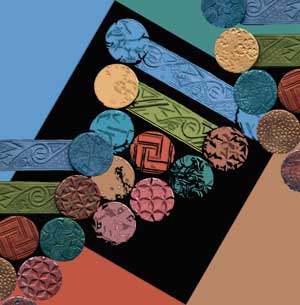 My, but what a lot of traveling I’ve done this Autumn! The Holiday Food and Gift show in Denver, The International Quilt Festival in Houston, and two days of classes in Columbus Ohio with the polymer clay guild there. I had a great time with them, and also got a chance to get together with family and friends.
My, but what a lot of traveling I’ve done this Autumn! The Holiday Food and Gift show in Denver, The International Quilt Festival in Houston, and two days of classes in Columbus Ohio with the polymer clay guild there. I had a great time with them, and also got a chance to get together with family and friends.
I’ve got an upcoming Bead Buglearticle about the results from the millefiore caning, mimicking textiles, and beautiful beads classes. It should be on-line sometime this month.
Shown at left are a pair of earring dangles (no hooks on them yet!) made from canes made in those classes. I’ve been having fun making charms and dangles with baked cane slices using my leather mini-hole punch from Tool-Smith. It makes the cleanest easiest holes through baked polymer clay!
 The triangles at the bottom of the dangles show one way that color can be gradated in polymer clay canes. This kind of “3D” color gives the illusion of blend when it is taken very small. You can also see it in the petals of the rose shown here. Polymer clay artists David Forlano and Stephen Ford of “City Zen Cane” made this color stacking technique very popular at one time. Along with Judith Skinner’s “Skinner Blend”, these two techniques allow for the appearance of shaded parts in cane images. I love the way I can get a very graphic style in clay and then take it down in scale with reduction!
The triangles at the bottom of the dangles show one way that color can be gradated in polymer clay canes. This kind of “3D” color gives the illusion of blend when it is taken very small. You can also see it in the petals of the rose shown here. Polymer clay artists David Forlano and Stephen Ford of “City Zen Cane” made this color stacking technique very popular at one time. Along with Judith Skinner’s “Skinner Blend”, these two techniques allow for the appearance of shaded parts in cane images. I love the way I can get a very graphic style in clay and then take it down in scale with reduction!
 The wedge from which the dangle slice was cut was a leftover piece from the making of the cane shown at left. The similar uses of form, color and multiple repeats are very much present in textile designs too. Sandra McCaw uses these kinds of color stacks in her caning process. Hers is far more precise than mine, and taken to much greater levels of reduction and recombining. Its always interesting to see how different artists can use similar materials and techniques in ways that suit their own styles.
The wedge from which the dangle slice was cut was a leftover piece from the making of the cane shown at left. The similar uses of form, color and multiple repeats are very much present in textile designs too. Sandra McCaw uses these kinds of color stacks in her caning process. Hers is far more precise than mine, and taken to much greater levels of reduction and recombining. Its always interesting to see how different artists can use similar materials and techniques in ways that suit their own styles.


